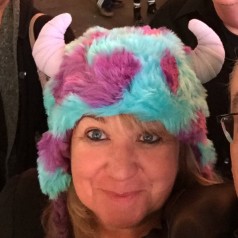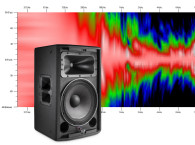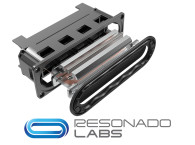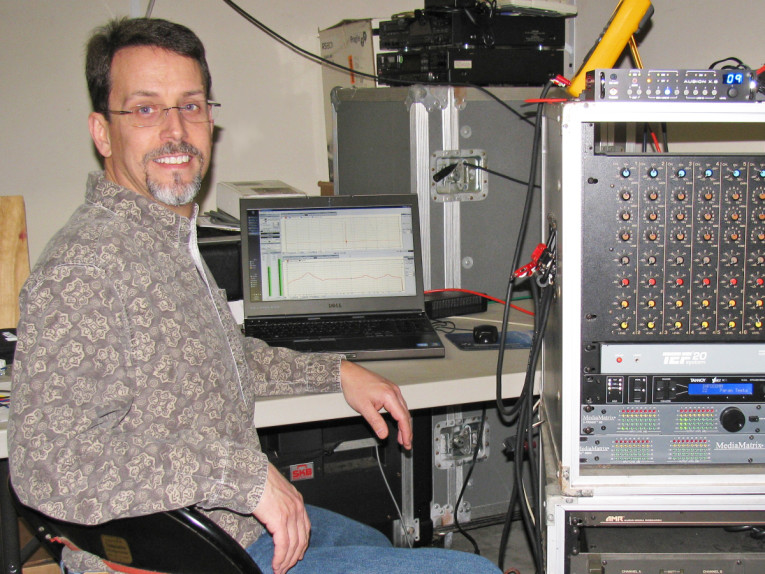
Shannon Becker: Tell us a little about your background and where you live.
Charlie Hughes: I’ve been involved with designing loudspeaker systems professionally for about 25 years. Prior to that, I worked mixing and recording live music in high school and a little bit in college. I earned a Physics degree from the Georgia Institute of Technology. I was very fortunate to have studied under Dr. Eugene Patronis while I was there. I currently live in Gastonia, NC, about 20 minutes from Charlotte.
Shannon: How did you become interested in audio electronics?
Charlie: My interest isn’t so much electronics as it is loudspeakers. Of course, I have an interest in amplifiers, DSP, mixers, and the like. However, this is secondary to loudspeakers, how to measure their performance, and how to design them to sound good.
Shannon: Describe your career as a loudspeaker design engineer. What are some of the highlights?
Charlie: I started working at Peavey Electronics in Meridian, MS, right after graduating from Georgia Tech. I was there for almost 14 years. After I left Peavey, I spent a short time at Altec Lansing in Milford, PA, as the chief engineer for its pro audio division, which the company was trying to resurrect. In late 2004, when I left Altec, I started Excelsior Audio, a consulting and loudspeaker design and measurement company working primarily with loudspeaker manufacturers.
I did a lot of horn design at Peavey, being the primary horn guy while I was there. I received my first patent (6,059,069) for a horn design concept. Having that patent issued was really cool. I also presented my first Audio Engineering Society (AES) paper on this type of horn design. I remember seeing Don Keele and Earl Geddes in the audience as I began my presentation. That was a bit intimidating at the time, although I had worked with both of them previously.
In 2000, I was asked to be an instructor at a TEF Level II workshop along with Don Eger and Russ Berger. That was a thrill because those guys are acoustical heavyweights! I knew a lot about the TEF platform and time delay spectrometry (TDS) measurement as applied to loudspeaker systems, so I guess I was able to hold my own.
Around the same time, I was programming MATLAB code to help optimize the crossover design for loudspeaker systems. This was mainly done in an effort to make the directivity response more consistent through the crossover region and to reduce the time in doing so by eliminating lots of repeated polar measurements. The resulting program, PolarSum, was very useful in this regard.
More recently I was asked to join the Ahnert Feistel Media Group (AFMG) based in Berlin, Germany, to consult on its software and help with advanced tech support and product training globally. This is the company responsible for the acoustical modeling program EASE. It also produces a couple of measurement programs, EASERA and SysTune. One of its other programs is SpeakerLab. This is an amazing program that, while doing some of the same things as PolarSum, takes loudspeaker modeling and design far beyond what anyone else I am aware of is doing in terms of directivity response.
Being asked to speak as a panelist for two State of the Art of Live Sound Loudspeaker Design seminars at AES conventions in 2008 and 2009 with Tom Danley (Danley Sound Labs), Dave Gunness (Fulcrum Acoustic), Aleš Dravinec (ADR Audio), and Pete Soper (Meyer Sound Labs) was a thrill. In 2010, I was asked to speak at an AES convention workshop with Floyd Toole and Peter Mapp about audio system coverage. To be included in the same company with all these gentlemen was indeed a great honor.
Beginning in 2004, I became the chairman of a CEA standards committee working group, CEA R3-WG1. I’m also active on several AES standards committees.
Shannon: While working at Peavey Electronics you were responsible for the design and development of many commercially successful products for the musical instrument, cinema, PA, studio monitor, and professional/install markets. Can you share some of the challenges involved with a couple of the most well-known designs? Are they still used today?
Charlie: At Peavey, some of the most popular loudspeakers are probably the SP series (e.g., SP-2, SP-3, etc.). I worked on several iterations of a couple of the models in this line. For these, there always seemed to be the issue of improving performance, maintaining reliability, and keeping the cost where it needed to be. Of course, this is probably no different than the challenges facing design engineers at many other companies. There was one instance when it was decided that the horn in the SP line needed updating. I think many of the models were using the older CH-2 at the time. I was tasked with the new horn design (what became the CH-941). Since it would be used across the board on the SP line, I wanted to make sure it was as good as I could make it at the time. There were some challenges to getting the directivity control as consistent as I wanted just above the low end cut-off of the horn. There was some narrowing of the coverage pattern in the midrange. I had to go back and study some of Don Keele’s AES papers as well as the work of Cliff Henricksen and Mark Ureda. Getting the secondary flare angles correct near the horn mouth helped with this.
The Q Wave series (later the QW series) was another line where a new horn design was used. This time it was one of the new Quadratic Throat horns. The same horn was used on several of the models in this line. It worked very well. I was to design a three-way system for the line. This required a new MF horn along with a new HF horn that would use a smaller compression driver. The MF horn required a closed-back 6.5” MF driver. It was difficult getting the right driver for this system. I know I had to have made Tom James (Eminence Speakers) crazy with all of the back and forth to get this driver dialed in to get the right performance, low frequency extension, and power handling. He did it though, and it is the heart of that loudspeaker system.
Shannon: What made you venture out on your own and start Excelsior Audio?
Charlie: The truth is my wife had a lot to do with it. She had been kicking me in the backside for quite some time to start my own business. She had more faith in me than I did! When I left Altec Lansing in 2004 it seemed like the right time to give it a shot.
Shannon: Can you discuss your best experience thus far?
Charlie: That’s a tough one because I’ve been blessed to have so many. If I had to pick one thing, I would have to say it would be getting involved with Synergetic Audio Concepts (SynAudCon). This is an education consortium started by Don and Carolyn Davis to help raise the level of knowledge in the audio industry. When Don and Carolyn retired it was taken over by Pat and Brenda Brown.
I have learned so much from other SynAudCon members: guys like Jay Mitchell, Dave Gunness, Tom Danley, Bruce Olson, Jim Brown, Peter Mapp, Ray Rayburn, Bill Whitlock, and so many others. Without the knowledge, contacts, and friendships I have made stemming from SynAudCon there is no way I would be where I am today.
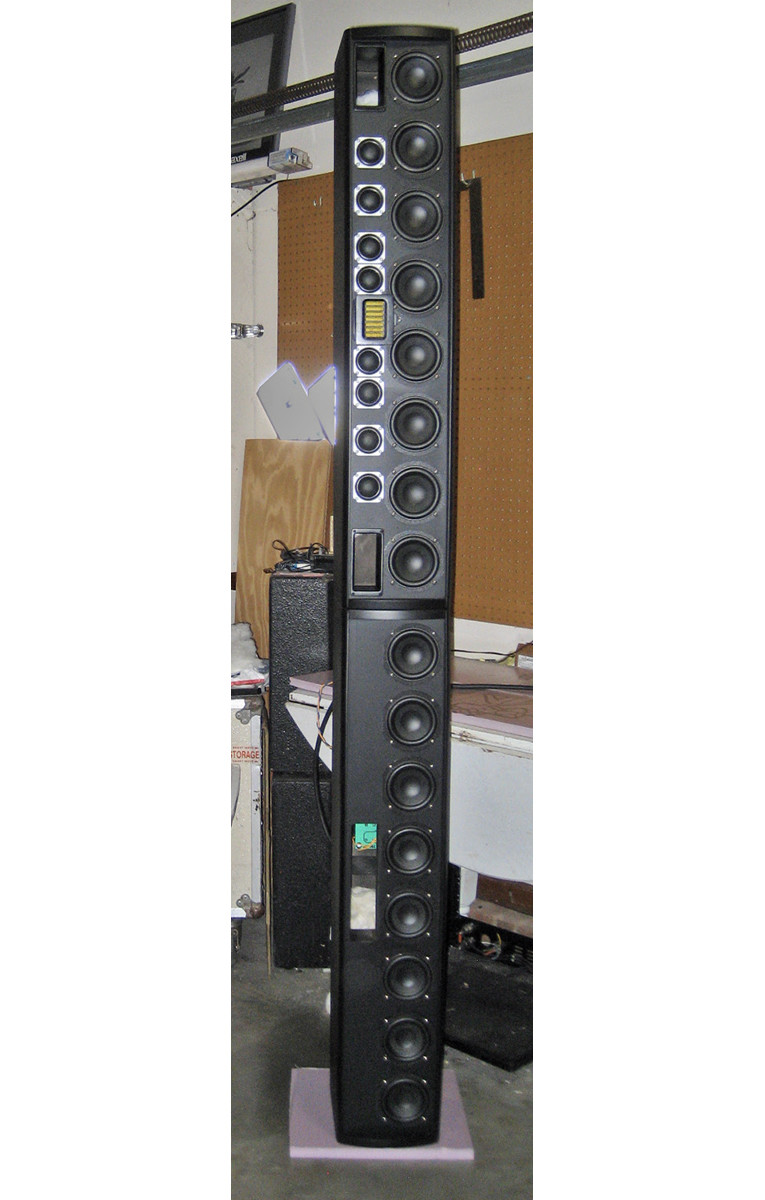
Shannon: What was your first personal project? Is it still in use?
Charlie: Wow, time to go way back. I think the first personal project I did was the loudspeaker system I designed and built for my senior design project at Georgia Tech. A rather substantial project was required to graduate. Mine was a three-way loudspeaker system. I thought they sounded fairly good at the time, but they looked atrocious! Woodworking was not one of my accomplished skills at the time, nor is it now. I like to think I design them a lot better than I can build them.
I had these and used them from 1987 until about 2001. I made some major changes (complete redesign and rebuild) to the passive crossovers around 1995 that greatly improved the sound. Several years later, the drivers became too deteriorated and they were not worth trying to salvage.
Shannon: You wrote an article, “Subwoofer Alignment with a Full-Range System” (audioXpress, January 2012). Did you create this project for your personal system? Do you still use the system?
Charlie: Not really. This was the result of some work from 2002. I was at a SynAudCon workshop about loudspeaker and acoustical testing and measurement. A question was asked of the instructors regarding the alignment of subs and full-range systems. This sparked a, shall we say, enthusiastic discussion amongst a couple of the instructors. However, the question never really did seem to get answered. I spent a lot of time thinking about this topic and what the right answer should be. By investigating the behavior of individual low-pass and high-pass filters, as well as their summation, I think I found the answer.
I think this is really only an issue when the distance between the subwoofer and full-range system is quite large acoustically (i.e., in excess of one-quarter wavelength in the crossover region). Otherwise, there is not enough phase difference to adversely affect system performance (home systems). In large concert PA systems this distance can be quite large and the cause of substantial problems. I’m hopeful that more people will implement my method and find it to be a useful solution. A video of a talk I gave on this can be found on YouTube and a PDF of the slides downloaded from my website.
Shannon: Are you currently working on any audio projects? If so, could you tell us a little about them?
Charlie: Yes, I finished the design work not too long ago for a project I did for SoundTube. This was a three-way fixed, single-box line array with an add-on low frequency directivity extension (LFDE) box. One of the interesting things I was able to do with this design is to frequency shade each pass band (except the HF) to maintain fairly constant vertical directivity control (with respect to frequency) as well as have a fairly short extent of the near-field across the entire operating range of the loudspeaker. Neither of these useful performance aspects is typically embodied in a line array. It is essentially a line array that performs as a point source. Thus, we dubbed the design methodology LAPS (line-array point source).
Another project that is nearing completion for Bag End is a line of three two-way loudspeakers, each with a 10”, 12”, and 15” woofer, respectively. I designed the high-frequency horn, the vented enclosure for each, as well as the internal passive crossovers. We employed a passive all-pass filter in these crossovers to help time align the output from the LF and HF pass bands. I’ve also developed DSP filtering for use as front-end EQ as well as for driving the loudspeakers in a biamp configuration.
An interesting aspect of the EQ used for these loudspeakers is that it is based on the frequency response at multiple listening positions, both on- and off-axis. By post-processing many off-axis measurements we were able to better determine what frequency regions would benefit the best from EQ and which ones to leave alone. Equalizing a loudspeaker based solely on a single frequency-response measurement typically will not yield results as good as this method.
There are some other projects currently in the works but they’re not close enough to completion to be able to discuss them.

Shannon: What do you see as some of the greatest audio innovations of your time?
Charlie: I think the TDS measurement method by Richard Heyser was a great innovation for loudspeaker measurement and analysis. There are others methods, such as dual-channel FFT using a log-swept sine stimulus (Angelo Farina) that are also useful.
The realization that the “sound” of a loudspeaker has more to do with its off-axis radiation than the on-axis frequency response is an unassailable truth when listening to loudspeakers in rooms, but it is amazing how many people still don’t get it.
The use of FIR filtering in the DSP available today to make loudspeakers more accurate in terms of the reproduction of the input signal to the system is also a great advance.
Shannon: Do you have any advice for audioXpress readers who are thinking of building their own sound systems?
Charlie: Read Floyd Toole’s book Sound Reproduction, Loudspeakers and Rooms, (Elsevier, 2008). Pay just as much attention to the off-axis response of loudspeakers as the on-axis response. Get the directivity response of the system as consistent as possible across as wide of a frequency range as possible. Avoid abrupt changes in the directivity response. These are most likely to occur through the crossover region. Also, get it right in the time domain. I think that, audibly, this is more important than the frequency domain.
And, have fun! If you don’t enjoy what you’re doing, it’s time to find something else to do. aX
This article was originally published in audioXpress, February 2013.


